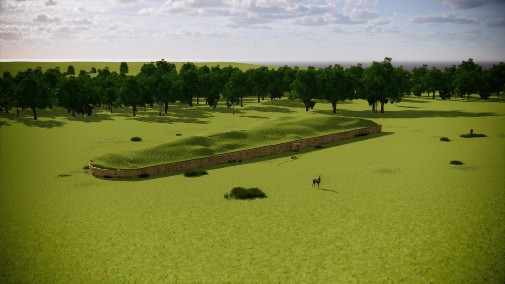Ancient DNA reveals the world’s oldest family tree
Posted on 22 December 2021
 The cairn at Hazleton North included two L-shaped burial chambers. Pic Credit: Newcastle University
The cairn at Hazleton North included two L-shaped burial chambers. Pic Credit: Newcastle University
In a study published in Nature, researchers analysed DNA extracted from the bones and teeth of 35 individuals entombed approximately 5700 years ago at Hazleton North long cairn in the Cotswolds-Severn region. They found that 27 of them were descended from four women who all had children with the same man.
Kinship
The group lived around 100 years after farming had been introduced to Britain and the authors of the study say that the results provide new insights into kinship and burial practices in Neolithic times.
Co-author of the study, Dr Lindsey Büster from the Department of Archaeology at the University of York, said: “This breakthrough study demonstrates the potential of fully integrated cultural and biomolecular approaches to understanding past societies and offers us a glimpse into the ways people who lived and died thousands of years ago articulated their relationships with one another”.
The cairn at Hazleton North included two L-shaped burial chambers which were located north and south of the main ‘spine’ of the linear structure. The research findings indicate that men were generally buried with their father and brothers, suggesting that descent was patrilineal with later generations buried at the tomb connected to the first generation entirely through male relatives.
While two of the daughters of the lineage who died in childhood were buried in the tomb, the complete absence of adult daughters suggests that their remains were placed either in the tombs of male partners with whom they had children, or elsewhere.
Memories
Although the right to use the tomb ran through patrilineal ties, the choice of whether individuals were buried in the north or south chambered area initially depended on the first-generation woman from whom they were descended, suggesting that these first-generation women were socially significant in the memories of this community.
The researchers also found indications that ‘stepsons’ (males whose mother was buried in the tomb but not their biological father, and whose mother had also had children with a male from the patriline) were adopted into the lineage.
Additionally, the team found no evidence that another eight individuals were biological relatives of those in the family tree, which might further suggest that biological relatedness was not the only criterion for inclusion. However, three of these were women and it is possible that they could have had a partner in the tomb but either did not have any children or had daughters who reached adulthood and left the community so are absent from the tomb.
Co-author of the study, Professor Ian Armit, from the Department of Archaeology at the University of York, said: “One of the most intriguing aspects of this work is the way it illuminates the complexity of kinship structures in prehistoric societies. Although biological relatedness was fundamental, we can also start to see kinship being expressed through social bonds like adoption.”
Family
Dr Chris Fowler of Newcastle University, the first author and lead archaeologist of the study, added: “This study gives us an unprecedented insight into kinship in a Neolithic community. The tomb at Hazleton North has two separate chambered areas, one accessed via a northern entrance and the other from a southern entrance, and just one extraordinary finding is that initially each of the two halves of the tomb were used to place the remains of the dead from one of two branches of the same family. This is of wider importance because it suggests that the architectural layout of other Neolithic tombs might tell us about how kinship operated at those tombs.”
Further information:
The work received primary funding from a Ramón y Cajal grant from the Ministerio de Ciencia e Innovación of the Spanish Government, Ikerbasque – Basque Foundation of Science, the US National Institutes of Health, the John Templeton Foundation, a private gift from Jean-François Clin, the Allen Discovery Center program, a Paul G. Allen Frontiers Group advised program of the Paul G. Allen Family Foundation, and the Howard Hughes Medical Institute.
Explore more news

Climate change set to take over as key driver of biodiversity loss by 2050, experts warn
Thursday 25 April 2024

Conservation actions are effective at halting and reversing biodiversity loss, study reveals
Thursday 25 April 2024

More than a quarter of people with Covid infection develop Long Covid, new research reveals
Thursday 25 April 2024
.jpg)
University of York awarded £1.1 million to lead the first stage of UK’s first comprehensive study on devolution and social security
Thursday 25 April 2024

More hybrid and nature-based solutions are urgently need to protect coastal communities from climate change
Wednesday 24 April 2024
Media enquiries
About this research
In a study published in Nature, researchers analysed DNA extracted from the bones and teeth of 35 individuals entombed approximately 5700 years ago at Hazleton North long cairn in the Cotswolds-Severn region. They found that 27 of them were descended from four women who all had children with the same man.
The project was an international collaboration between archaeologists from the Universities of Newcastle, York, Exeter and Central Lancashire, and geneticists at the University of Vienna, University of the Basque Country and Harvard University. Corinium Museum, Cirencester, provided permission to sample the remains in their collection.
Explore our research
